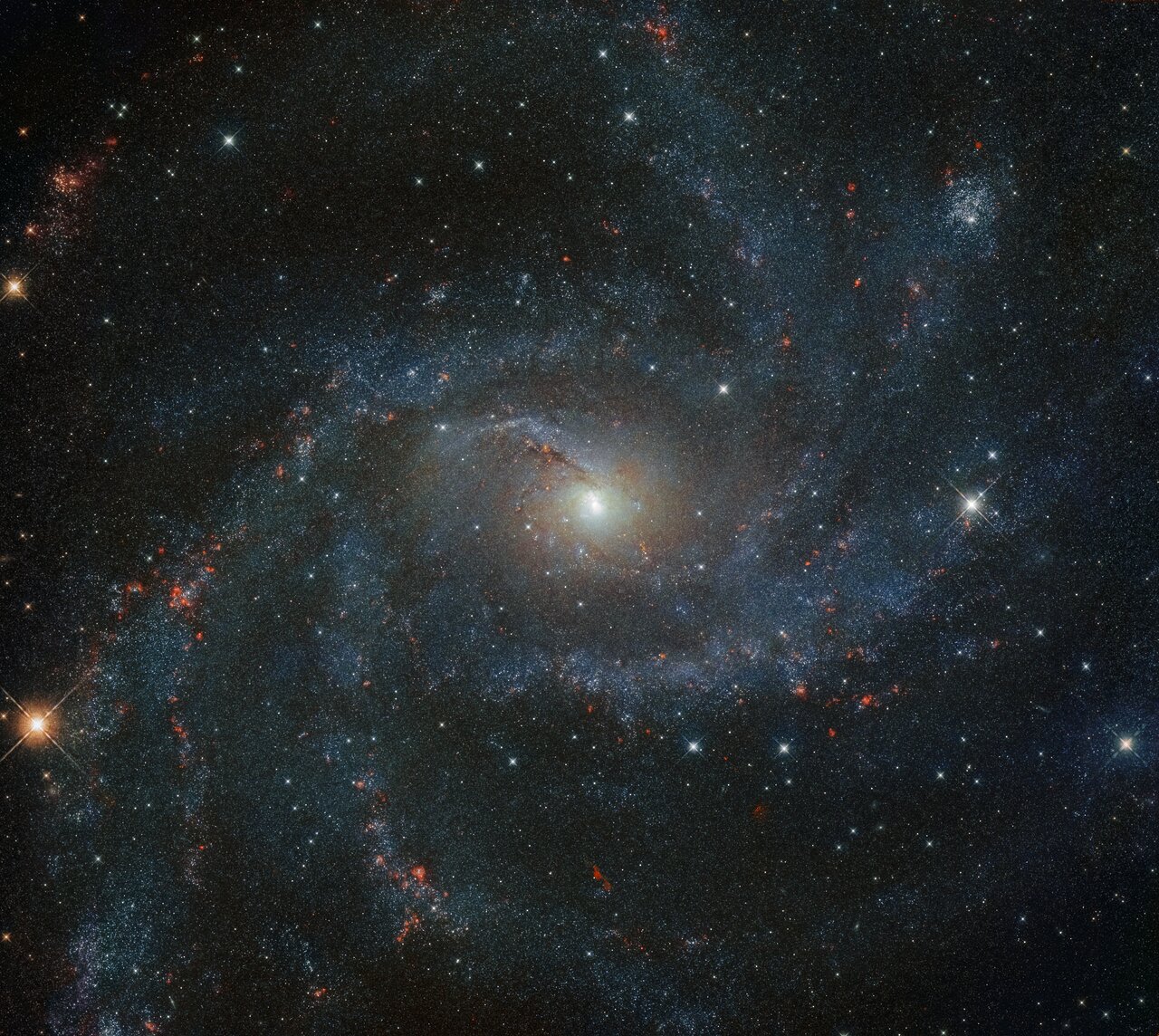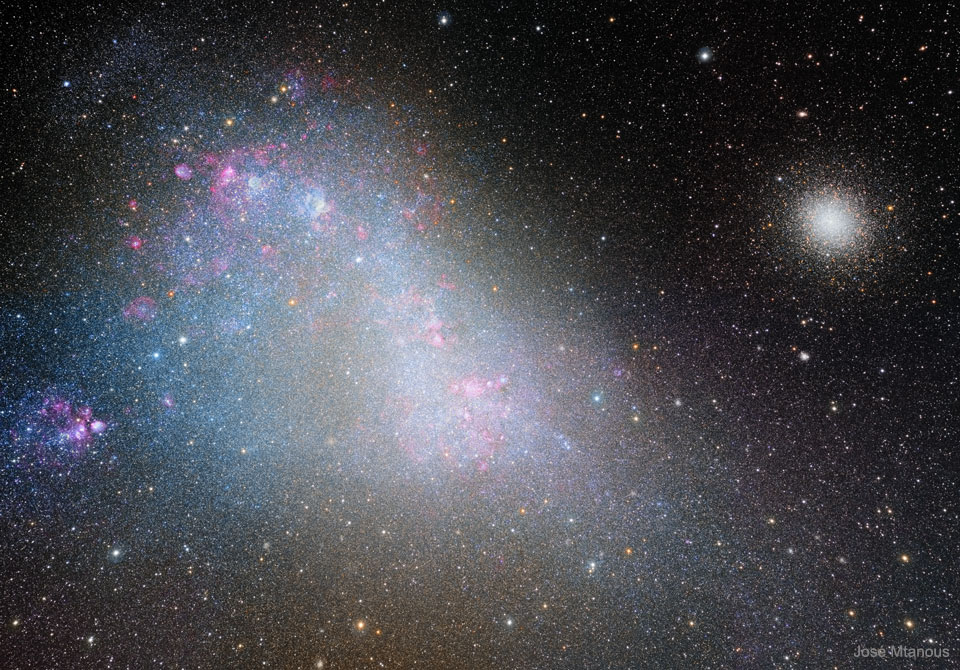Blog

The galaxy NGC 6946 is nothing short of spectacular. In the last century alone, NGC 6946 has experienced 10 observed supernovae, earning its nickname as the Fireworks Galaxy. In comparison, our Milky Way averages just 1-2 supernova events per century. This NASA/ESA Hubble Space Telescope image shows the stars, spiral arms, and various stellar environments of NGC 6946 in phenomenal detail. We are able to marvel at NGC 6946 as it is a face-on galaxy, which means that we see the galaxy “facing” us, rather than seeing it from the side (known as edge-on). The Fireworks Galaxy is further classified as an intermediate spiral galaxy and as a starburst galaxy. The former means the structure of NGC 6946 sits between a full spiral and a barred spiral galaxy, with only a slight bar in its centre, and the latter means it has an exceptionally high rate of star formation. The galaxy resides 25.2 million light-years away, along the border of the northern constellations of Cepheus and Cygnus (The Swan).

Alexandra Elene MacLean Denny (6 January 1947 – 21 April 1978) was an English singer-songwriter who was lead singer of the British folk rockband Fairport Convention. She has been described as “the pre-eminent British folk rock singer”.
After briefly working with the Strawbs, Denny joined Fairport Convention in 1968, remaining with them until 1969. She formed the short-lived band Fotheringay in 1970, before focusing on a solo career. Between 1971 and 1977, Denny released four solo albums: The North Star Grassman and the Ravens, Sandy, Like an Old Fashioned Waltz and Rendezvous. She also duetted with Robert Plant on “The Battle of Evermore” for Led Zeppelin‘s album Led Zeppelin IV in 1971. Denny died in 1978 at the age of 31 due to injuries and health issues related to alcohol abuse.
Music publications Uncut and Mojo have called Denny Britain’s finest female singer-songwriter. Her composition “Who Knows Where the Time Goes?” has been recorded by Judy Collins, Eva Cassidy, Nina Simone, 10,000 Maniacs and Cat Power. Her recorded work has been the subject of numerous reissues, along with a wealth of previously unreleased material which has appeared over the more than 40 years since her death, most notably including a 19-CD box set which was released in November 2010.
more...Roger Keith “Syd” Barrett (6 January 1946 – 7 July 2006) was an English singer, songwriter, and musician who co-founded the rock band Pink Floydin 1965. Barrett named the group and was their original frontman and primary songwriter, becoming known for his English-accented singing, literary influences, and whimsical take on psychedelia. As a guitarist, he was influential for his free-form playing and for employing dissonance, distortion, echo, feedback, and other studio effects.
Barrett was musically active for less than ten years. With Pink Floyd, he recorded four singles, their debut album The Piper at the Gates of Dawn(1967), portions of their second album A Saucerful of Secrets (1968), and several unreleased songs. In April 1968, Barrett was ousted from the band amid speculation of mental illness and his excessive use of psychedelic drugs. He began a brief solo career in 1969 with the single “Octopus” and followed with the albums The Madcap Laughs (1970) and Barrett (1970), recorded with the aid of several members of Pink Floyd.
In 1972, Barrett left the music industry, retired from public life and strictly guarded his privacy until his death. He continued painting and dedicated himself to gardening. Pink Floyd recorded several tributes and homages to him, including the 1975 song suite “Shine On You Crazy Diamond” and the 1979 rock opera The Wall. In 1988, EMI released an album of unreleased tracks and outtakes, Opel, with Barrett’s approval. He died of pancreatic cancer in 2006.
more...
Paolo Conte (Italian pronunciation: [ˈpaolo ˈkonte]; born 6 January 1937) is an Italian singer, pianist, composer, and lawyer notable for his grainy, resonant voice. His compositions are evocative of Italian and Mediterranean sounds, as well as of jazz music and South American atmospheres.
Paolo Conte was born in Asti, Piedmont. His parents were avid jazz fans and Conte and his younger brother Giorgio spent their formative years listening to a lot of early jazz and blues recordings. After obtaining a law degree at the University of Parma, Conte started working as an assistant solicitor with his father, simultaneously pursuing his musical studies. He learned to play the trombone, the vibraphone and the piano, and formed a jazz band with his brother on guitar. Conte’s skill for composing music and original arrangements was noted by music producer Lilli Greco, who paired Conte with lyricist Vito Pallavicini. They wrote songs for Adriano Celentano (“Azzurro“, 1968), Caterina Caselli (“Insieme a te non ci sto più”, 1968), Fausto Leali (“Deborah”, 1968) and Enzo Jannacci (“Messico e nuvole”, 1970). In 1974 Conte recorded his first album, Paolo Conte. The following year, he released another eponymous album. Following a series of well-received shows at Club Tenco in Sanremo in 1976 and the commercial success of his third album, ‘Un gelato al limon’, Conte concentrated almost exclusively on his solo career.
Some of Conte’s most popular songs have been used as film soundtracks, including “Come Di” in I Am David (2003) and Mickey Blue Eyes (1999), “Via con me” in French Kiss (1995), Mostly Martha (2001) and Welcome to Collinwood (2002). In addition, Conte’s song “L’orchestrina” is featured during the end credits for episodes 3 and 4 of the television series The New Pope (2020). In 1997 Conte won the Nastro d’Argento for Best Score for the film La freccia azzurra.
more...Ebo Taylor (born 1936) is a Ghanaian guitarist, composer, bandleader, record producer and arranger focusing on highlife and afrobeat music.
Ebo Taylor has been a pivotal figure on the Ghanaian music scene for over six decades. In the late ’50s he was active in the influential highlife bands the Stargazers and the Broadway Dance Band. In 1962, Taylor took his group, the Black Star Highlife Band, to London. In London, Taylor collaborated with Nigerian afrobeat star Fela Kuti as well as other African musicians in Britain at the time.
Returning to Ghana, Taylor worked as a producer, crafting recordings for Pat Thomas, C.K. Mann, and others, as well as exploring solo projects, combining traditional Ghanaian material with afrobeat, jazz, and funk rhythms to create his own recognizable sound in the ’70s. He was the inhouse guitar player, arranger, and producer for Essiebons, founded by Dick Essilfie-Bondzie.
Taylor’s work became popular internationally with hip-hop producers in the 21st century. In 1992, Ghetto Concept included his afrobeats in their music. In 2008, Ebo Taylor met the Berlin-based musicians of the Afrobeat Academy band, including saxophonist Ben Abarbanel-Wolff, which led to the release of the album Love and Death with Strut Records (his first internationally distributed album).[1][6][7] In 2010, Usher used a sample from Taylor’s song “Heaven” for “She Don’t Know” with Ludacris.
more...Earl Eugene Scruggs (January 6, 1924 – March 28, 2012 Cleveland County, North Carolina) was an American musician noted for popularizing a three-finger banjo picking style, now called “Scruggs style“, which is a defining characteristic of bluegrass music. His three-finger style of playing was radically different from the traditional way the five-string banjo had previously been played. This new style of playing became popular and elevated the banjo from its previous role as a background rhythm instrument to featured solo status. He popularized the instrument across several genres of music.
Scruggs’ career began at age 21 when he was hired to play in Bill Monroe‘s band, the Blue Grass Boys. The name “bluegrass” eventually became the eponym for the entire genre of country music now known by that title. Despite considerable success with Monroe, performing on the Grand Ole Opryand recording classic hits such as “Blue Moon of Kentucky“, Scruggs resigned from the group in 1946 due to their exhausting touring schedule. Fellow band member Lester Flatt resigned as well, and he and Scruggs later paired up in a new group they called Flatt and Scruggs and the Foggy Mountain Boys. Scruggs’ banjo instrumental called “Foggy Mountain Breakdown“, released in 1949, became an enduring hit, and had a rebirth of popularity to a younger generation when it was featured in the 1967 film Bonnie and Clyde. The song won two Grammy Awards and, in 2005, was selected for the Library of Congress’ National Recording Registry of works of unusual merit.
Flatt and Scruggs brought bluegrass music into mainstream popularity in the early 1960s with their country hit, “The Ballad of Jed Clampett” — the theme music for the television sitcom The Beverly Hillbillies — the first Scruggs recording to reach number one on the Billboard charts. Over their 20-year association, Flatt and Scruggs recorded over 50 albums and 75 singles. The duo broke up in 1969, chiefly because, while Scruggs wanted to switch styles to fit a more modern sound, Flatt was a traditionalist who opposed the change and believed doing so would alienate a fan base of bluegrass purists. Although each of them formed a new band to match their visions, neither of them ever regained the success they had achieved as a team.
Scruggs received four Grammy awards, a Grammy Lifetime Achievement Award and a National Medal of Arts. He became a member of the International Bluegrass Music Hall of Fame and was given a star on the Hollywood Walk of Fame. In 1985, Flatt and Scruggs were inducted together into the Country Music Hall of Fame and named, as a duo, number 24 on CMT‘s “40 Greatest Men of Country Music”. Scruggs was awarded a National Heritage Fellowship by the National Endowment for the Arts, the highest honor in the folk and traditional arts in the United States. Four works by Scruggs have been placed in the Grammy Hall of Fame. After Scruggs’ death in 2012 at age 88, the Earl Scruggs Center was founded near his birthplace in Shelby, North Carolina, with the aid of a federal grant and corporate donors. The center is a $5.5 million facility that features the musical contributions of Scruggs and serves as an educational center providing classes and field trips for students.
more...Yiannis Papaioannou (Greek: Ιωάννης Ανδρέου Παπαιωάννου; 6 January 1910, Kavala – 19 May 1989, Athens) was a Greek composer and teacher of the Modern Era. He studied piano with Marika Laspopoulou and composition with Alekos Kontis at the Hellenic Conservatory in Athens(1922–34), as well as the piano and orchestration with Emilios Riadis in Thessaloniki (1928–29).
In 1949 he visited major European music centres on a UNESCO grant and became familiar with new developments in music composition. In particular, in Paris he attended Arthur Honegger‘s class. Between 1951 and 1961 he taught music at an Athens high school and from 1953 he was professor of counterpoint and composition at the Hellenic Conservatory. He was the first president of both the Greek section of the International Society for Contemporary Music (1964–75) and the Hellenic Association for Contemporary Music (1965–75).
Papaioannou was the first musician to systematically teach atonal, 12-note and serial techniques before 1970. His compositional career falls into five main phases: Early Impressionist (1932–8), National School (1939–43), Hindemithian neo-classicism combined with elements of Byzantine music(1944–52), 12-note period (1953–1966) and the last period (1966–89) in which he developed an entirely personal technique.
more...Small Magellanic Cloud? It has turned out to be a galaxy. People who have wondered about this little fuzzy patch in the southern sky included Portuguese navigator Ferdinand Magellan and his crew, who had plenty of time to study the unfamiliar night sky of the south during the first circumnavigation of planet Earth in the early 1500s. As a result, two celestial wonders easily visible for southern hemisphere skygazers are now known in Western culture as the Clouds of Magellan. Within the past 100 years, research has shown that these cosmic clouds are dwarf irregular galaxies, satellites of our larger spiral Milky Way Galaxy. The Small Magellanic Cloud actually spans 15,000 light-years or so and contains several hundred million stars. About 210,000 light-years away in the constellation of the Tucan (Tucana), it is more distant than other known Milky Way satellite galaxies, including the Sagittarius Dwarf galaxy and the Large Magellanic Cloud. This sharp image also includes the foreground globular star cluster 47 Tucanae on the right.

Paul Wertico (born January 5, 1953 in Chicago, Illinois) is an American drummer. He gained recognition as a member of the Pat Metheny Group from 1983 until 2001, leaving the group to spend more time with his family and to pursue other musical interests.
After Pat Metheny heard the Simon and Bard Group with Wertico and bassist Steve Rodby, he invited both to join his band. During his time with Metheny, Wertico played on ten albums and four videos, appeared on television, and toured around the world. He won seven Grammy Awards (for “Best Jazz Fusion Performance,” “Best Contemporary Jazz Performance,” and “Best Rock Instrumental Performance”), magazine polls, and received several gold records.
He formed the Paul Wertico Trio with John Moulder and Eric Hochberg and collaborated with Larry Coryell, Kurt Elling, and Jeff Berlin. From 2000 to 2007, he was a member of SBB, the platinum-record-winning Polish progressive rock band. Wertico was a member of the Larry Coryell Power Trio until Coryell’s death in 2017.
more...Cees See (January 5, 1934, Amsterdam – December 9, 1985, The Hague) was a Dutch jazz drummer.
See worked in the 1950s with Freddy Logan and Jack Sels, and in the early 1960s with Rolf Kühn, Pim Jacobs, and Herman Schoonderwalt. He also played with an ensemble formed for Sender Freies Berlin, whose members included Herb Geller and Jerry van Rooyen. In the second half of the 1960s he played with Teddy Wilson, Klaus Doldinger, Volker Kriegel, Dusko Goykovich, Nathan Davis, and Jan Hammer. He was a member of the New Jazz Trio with Manfred Schoof and Peter Trunk in 1970-1972, and in the early 1970s also continued to work with Kriegel and Goykovich, as well as with Wolfgang Dauner and Chris Hinze.
more...Alvin Ailey (January 5, 1931 – December 1, 1989 Rogers, TX), a.k.a. Alvin Ailey Jr., was an African-American dancer, director, choreographer, and activist who founded the Alvin Ailey American Dance Theater (AAADT). He created AAADT and its affiliated Ailey School as havens for nurturing black artists and expressing the universality of the African-American experience through dance. His work fused theatre, modern dance, ballet, and jazz with black vernacular, creating hope-fueled choreography that continues to spread global awareness of black life in America. Ailey’s choreographic masterpiece Revelations is recognized as one of the most popular and most performed ballets in the world. In this work he blended primitive, modern and jazz elements of dance with a concern for black rural America. On July 15, 2008, the United States Congress passed a resolution designating AAADT a “vital American cultural ambassador to the World.” That same year, in recognition of AAADT’s 50th anniversary, then Mayor Michael Bloomberg declared December 4 “Alvin Ailey Day” in New York City while then Governor David Paterson honoured the organization on behalf of New York State.
more...Elizabeth “Libba” Cotten (née Nevills) (January 5, 1893 – June 29, 1987) was an American blues and folk musician, singer, and songwriter.
A self-taught left-handed guitarist, Cotten developed her own original style. She played a guitar strung for a right-handed player, but played it upside down, as she was left-handed. This position meant that she would play the bass lines with her fingers and the melody with her thumb. Her signature alternating bass style has become known as “Cotten picking”.
Cotten was born in 1893 to a musical family near Chapel Hill, North Carolina, in an area that would later be incorporated as Carrboro. Her parents were George Nevill (also spelled Nevills) and Louisa (or Louise) Price Nevill. Elizabeth was the youngest of five children. She named herself on her first day of school, when the teacher asked her name, because at home she was only called “Li’l Sis.” At age 7, she began to play her older brother’s banjo. “From that day on,” she said, “nobody had no peace in that house”. By the age of 8, she was playing songs. At age 9, she was forced to quit school and began work as a domestic. At the age of 12, she had a live-in job at Chapel Hill. She earned a dollar a month, that her mother saved up to buy her first guitar.The guitar, a Sears and Roebuck brand instrument, cost $3.75 (equivalent to $107 in 2019). Although self-taught, she became proficient at playing the instrument, and her repertoire included a large number of rags and dance tunes.
more...More Posts
- Sonny Criss Day
- World Music with Paulo Tato Marinho
- Daily Roots with Rising Sun
- The Cosmos with SN 1006
- Leslie West Day
- Candido Camero Day
- Cyril Blake Day
- Franz Liszt Day
- World Music with Tamikrest
- Daily Roots with Niyorah feat. House Of Shem
- The Cosmos with NGC 4485
- Celia Cruz Day
- Dizzy Gillespie Day
- Don Byas Day
- World Music with Ajay Srivastav
- Daily Roots with Rod Taylor
- The Cosmos with NGC 5090/91
- Anouar Brahem Day
- Tom Petty Day
- Eddie Harris Day